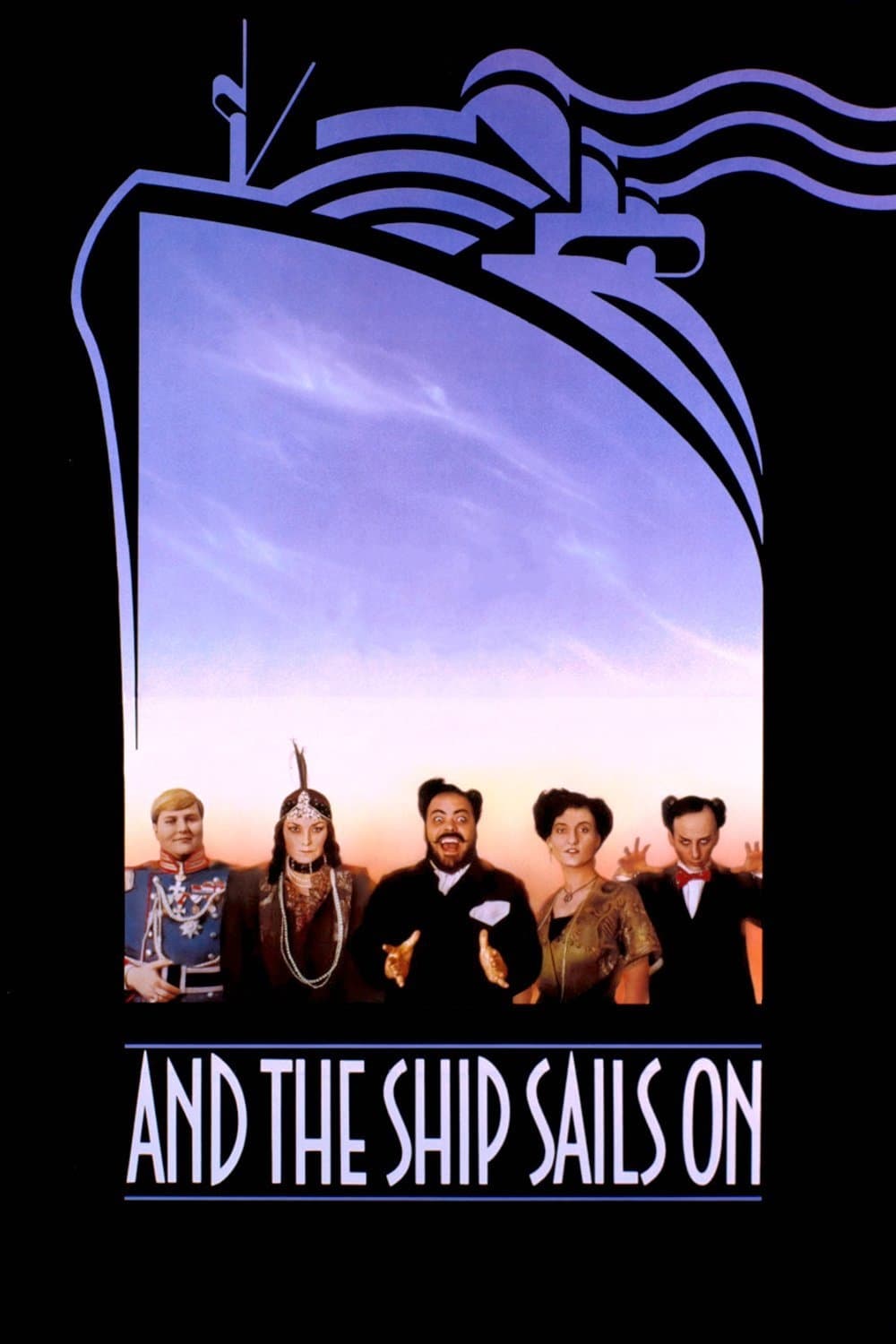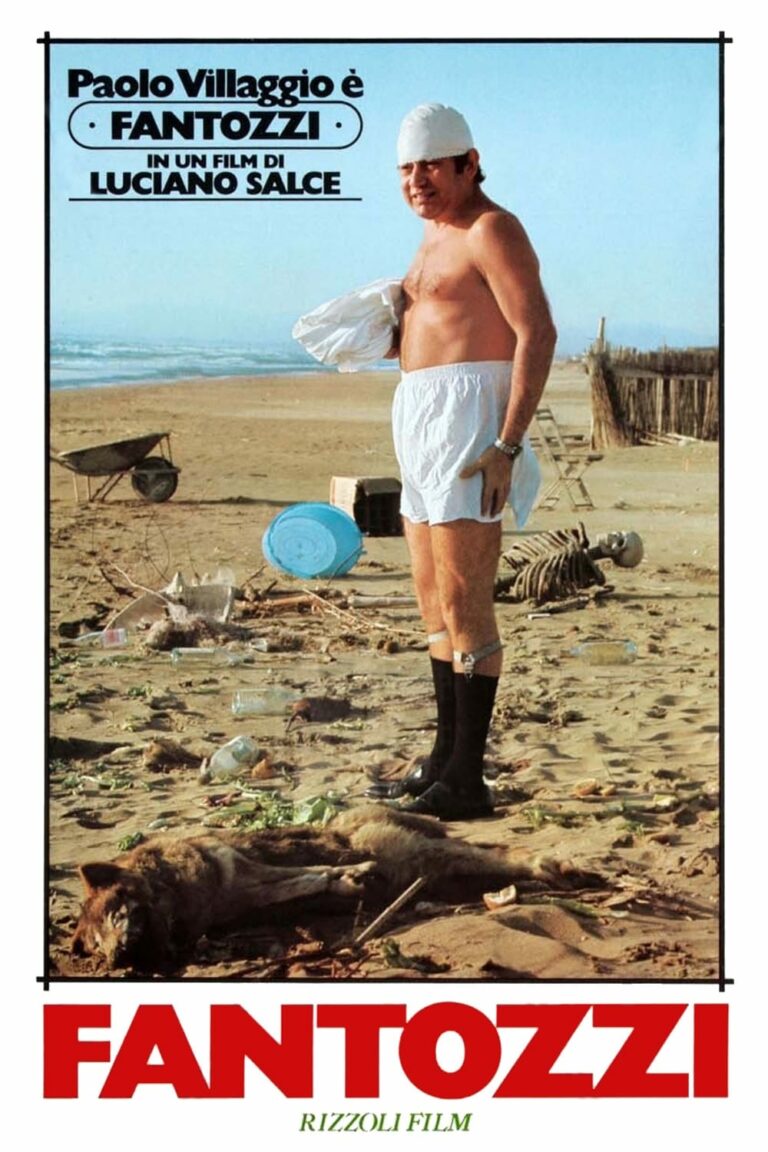
1. Introduction
And the Ship Sails On (E la nave va), directed by Federico Fellini and released in 1983, is a whimsical and deeply allegorical film that masterfully combines humor, pathos, and surrealism. Set in July 1914, just days before the outbreak of World War I, the story takes place on a luxurious ocean liner carrying an eccentric group of passengers—artists, aristocrats, and political figures—on a voyage to scatter the ashes of a renowned opera singer.
This late-career work of Fellini reflects his signature style: a blend of elaborate visuals, poignant character studies, and pointed social critique. And the Ship Sails On stands as a meditation on the fragility of art, culture, and human civilization, all set against the backdrop of an impending global catastrophe.
2. Plot Summary
The Journey Begins
The film opens with a silent-film aesthetic, introducing the viewer to the SS Gloria N., a grand ocean liner carrying an eclectic group of passengers. They are on a ceremonial voyage to scatter the ashes of Edmea Tetua, a legendary opera diva, near her birthplace on a remote Greek island. The guests include fellow opera singers, critics, aristocrats, and even a rhinoceros traveling in the ship’s cargo.
A World of Absurdity
As the journey progresses, the personalities of the passengers are revealed through their eccentricities and interactions. Amidst rehearsals, meals, and conversations, tensions emerge, reflecting the clashing ideologies and egos of the time.
The tranquility of the voyage is interrupted when the ship encounters a group of Serbian refugees fleeing political upheaval in the Balkans. These displaced individuals are welcomed aboard, but their presence brings a stark reminder of the growing instability in Europe.
The Inevitable Tragedy
As the ship nears its destination, tensions between the crew, passengers, and Serbian refugees escalate. The grand voyage culminates in a surreal and tragic climax as an Austrian warship appears, threatening the passengers and foreshadowing the horrors of the coming war. The liner, a microcosm of pre-war Europe, is ultimately consumed by the chaos that would soon engulf the continent.
3. Themes Explored in And the Ship Sails On
The Decline of Civilization
The passengers aboard the SS Gloria N. represent a decadent, self-indulgent elite on the brink of obsolescence. Their detachment from the realities of the world mirrors the cultural and moral decline of Europe before World War I.
Art as a Reflection of Society
Fellini uses opera—a symbol of high art and refinement—as a metaphor for the fragility of culture. The passengers’ reverence for Edmea Tetua contrasts with their inability to confront the growing political and social unrest.
Human Vulnerability and Mortality
The scattering of Edmea Tetua’s ashes serves as a poignant reminder of human impermanence. Despite their wealth and status, the passengers cannot escape their mortality or the tide of history.
The Absurdity of Human Behavior
Fellini’s characters, with their exaggerated quirks and interactions, reflect the absurdity of human behavior, especially when faced with existential threats. The mix of humor and tragedy underscores the futility of clinging to superficial comforts in the face of disaster.
4. Character Analysis
Orlando (Freddie Jones)
The film’s narrator, Orlando, is a journalist documenting the voyage. Through his observations, Orlando serves as the audience’s guide, providing both wit and insight into the eccentric world of the passengers. His detached perspective reflects Fellini’s own bemused view of human folly.
Edmea Tetua (Unseen)
Though Edmea Tetua never appears on screen, her presence looms large over the narrative. She represents the glory of art and the transience of fame, as her ashes become the focal point of the voyage.
The Passengers
The diverse passengers symbolize various facets of pre-war European society:
- The Opera Singers: Embody the grandeur and self-importance of the artistic elite.
- The Aristocrats: Represent a decaying upper class, blind to the shifting tides of history.
- The Critics and Scholars: Highlight the pretentiousness of intellectuals, more concerned with appearances than substance.
The Serbian Refugees
The refugees are a stark contrast to the ship’s passengers, symbolizing the harsh realities of political conflict and displacement. Their presence disrupts the passengers’ insulated world, bringing urgency and gravity to the narrative.
5. Federico Fellini’s Vision
Fellini, known for his fascination with human nature and society’s contradictions, uses And the Ship Sails On to reflect on the fragility of cultural institutions and the fleeting nature of human achievement. The ship becomes a metaphor for Europe on the brink of collapse—a vessel of decadence and denial heading toward destruction.
The film also showcases Fellini’s surrealist tendencies, blending dreamlike imagery with biting satire. His playful approach to storytelling invites viewers to question the nature of reality and illusion, creating a rich, multilayered narrative.
6. Cinematic Techniques
Visual Style
The film’s opening, presented as a silent film, sets the tone for its theatrical, stylized aesthetic. Fellini’s use of artificial sets and deliberately exaggerated visuals creates a sense of detachment, emphasizing the film’s allegorical nature.
Cinematography
Tonino Delli Colli’s cinematography captures the opulence of the ship’s interiors and the vastness of the open sea. The camera’s fluid movements mirror the ebb and flow of the narrative, drawing the viewer into the surreal world of the SS Gloria N.
Music
Nino Rota’s score, featuring operatic arias and haunting melodies, underscores the film’s themes of beauty and decay. The music serves as both a tribute to Edmea Tetua’s legacy and a poignant commentary on the impermanence of art.
7. Reception and Legacy
Critical Reception
Upon its release, And the Ship Sails On received praise for its visual inventiveness and thematic depth. Critics admired Fellini’s ability to blend humor, tragedy, and social critique, though some found the film’s allegorical nature overly didactic.
Awards
The film won several international accolades, including the David di Donatello Award for Best Director, cementing Fellini’s reputation as one of cinema’s great auteurs.
Legacy
And the Ship Sails On remains a vital part of Fellini’s oeuvre, offering a poignant commentary on the decline of cultural and societal values. Its allegorical approach has influenced countless filmmakers, demonstrating the power of cinema to blend entertainment with philosophical inquiry.
8. Symbolism in And the Ship Sails On
The Ship
The SS Gloria N. represents pre-war Europe—a vessel of excess and denial hurtling toward its inevitable destruction. The ship’s fate mirrors the fragility of human civilization.
The Rhinoceros
The rhinoceros, an odd and seemingly out-of-place character, symbolizes the absurdity of human priorities. Its presence aboard the ship highlights the passengers’ obliviousness to the world’s real problems.
The Ashes
Edmea Tetua’s ashes represent the fleeting nature of human achievement. Despite the passengers’ reverence, the ashes ultimately have little bearing on the unfolding chaos.
9. Frequently Asked Questions (FAQs)
1. What is the main message of And the Ship Sails On?
The film explores the fragility of art, culture, and human civilization in the face of political and social upheaval. It serves as a cautionary tale about the dangers of decadence and denial.
2. Is the film historically accurate?
While the film is set in 1914, it is not a historical drama. Instead, it uses the historical context as an allegorical backdrop for its commentary on human nature and societal decline.
3. What inspired Fellini to make this film?
Fellini drew inspiration from his love of opera and his fascination with the decline of European aristocracy. The film reflects his ongoing exploration of human vanity and the transient nature of fame and beauty.
4. How does the film compare to Fellini’s earlier works?
And the Ship Sails On continues Fellini’s tradition of blending surrealism with social critique, though it is more allegorical and reflective than his earlier films like La Dolce Vita or 8½.
5. Where can I watch And the Ship Sails On?
The film is available on various streaming platforms and as part of Fellini’s collected works in restored Blu-ray editions.
10. Conclusion
And the Ship Sails On is a deeply poetic and visually arresting film that showcases Federico Fellini’s unique ability to blend surrealism, humor, and social commentary. Through its allegorical narrative and rich character studies, the film offers a timeless reflection on the fragility of human civilization and the enduring power of art. Decades after its release, And the Ship Sails On remains a testament to Fellini’s unparalleled genius and his ability to create cinematic elegies for a vanishing world.





